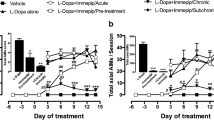Abstract
In order to characterize the development of orolingual motor effects of chronic haloperidol treatment in rats, this typical neuroleptic was administered for 102 days while daily measurements of tongue movement dynamics (peak force, lick rhythm, number of licks) during water licking were recorded. After chronic haloperidol dosing (vehicle, 0.06. 0.12, 0.24 mg/kg for four separate groups) for 32 days and continuing every second or third day of the chronic dosing period, the effects of cholinergic (scopolamine: 0.05–0.20 mg/kg; trihexyphenidyl: 0.15–1.0 mg/kg) or serotonergic (ritanserin: 0.5–4.0 mg/kg; quipazine: 0.5–4.0 mg/kg) probe drugs were examined for their capacity to antagonize the alterations in licking behavior induced by haloperidol. Haloperidol dose-dependently reduced peak force and number of licks, effects which were apparent within 2 or 3 days of the start of treatment. Significant effects of haloperidol on lick rhythm first emerged on day 13 and gradually increased in magnitude through the remaining treatment period. Scopolamine, trihexyphenidyl, and quipazine reduced haloperidol’s effects on at least one measure of licking behavior. During a 7-day haloperidol withdrawal period, the four dosage groups were similar on all measures of tongue dynamics. Overall, the results exhibited features suggesting the co-occurrence of Parkinson-like and tardive dyskinesia-like effects.
Similar content being viewed by others
Author information
Authors and Affiliations
Additional information
Received: 3 July 1997 / Final version: 22 October 1997
Rights and permissions
About this article
Cite this article
Fowler, S., Wang, G. Chronic haloperidol produces a time- and dose-related slowing of lick rhythm in rats: implications for rodent models of tardive dyskinesia and neuroleptic-induced parkinsonism. Psychopharmacology 137, 50–60 (1998). https://doi.org/10.1007/s002130050592
Issue Date:
DOI: https://doi.org/10.1007/s002130050592




